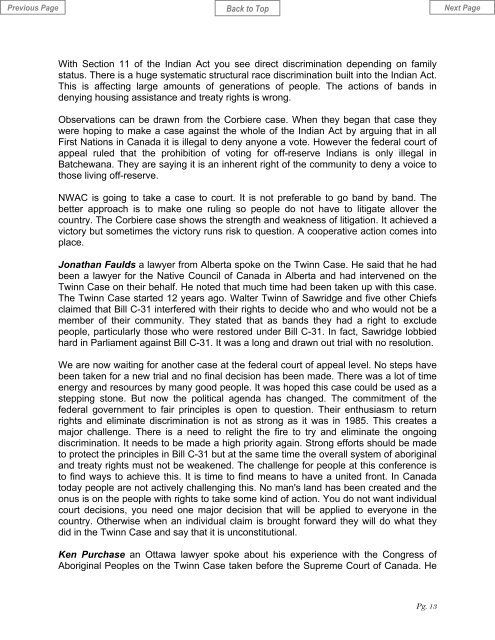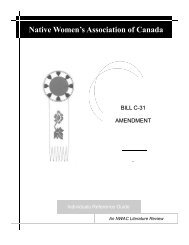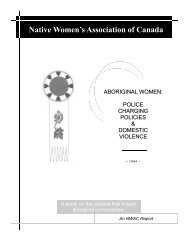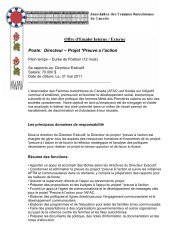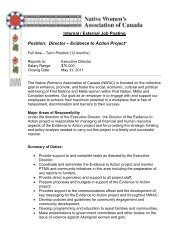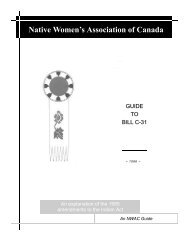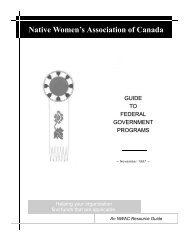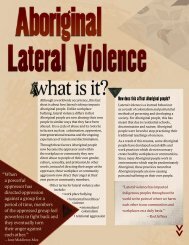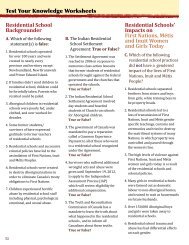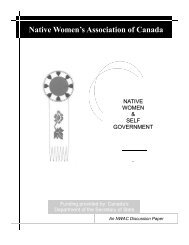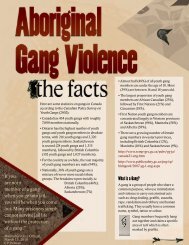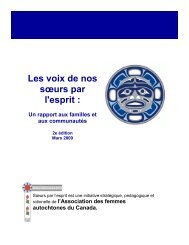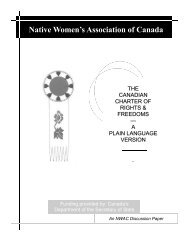BILL C-31 - Native Women's Association of Canada Website
BILL C-31 - Native Women's Association of Canada Website
BILL C-31 - Native Women's Association of Canada Website
- No tags were found...
You also want an ePaper? Increase the reach of your titles
YUMPU automatically turns print PDFs into web optimized ePapers that Google loves.
With Section 11 <strong>of</strong> the Indian Act you see direct discrimination depending on familystatus. There is a huge systematic structural race discrimination built into the Indian Act.This is affecting large amounts <strong>of</strong> generations <strong>of</strong> people. The actions <strong>of</strong> bands indenying housing assistance and treaty rights is wrong.Observations can be drawn from the Corbiere case. When they began that case theywere hoping to make a case against the whole <strong>of</strong> the Indian Act by arguing that in allFirst Nations in <strong>Canada</strong> it is illegal to deny anyone a vote. However the federal court <strong>of</strong>appeal ruled that the prohibition <strong>of</strong> voting for <strong>of</strong>f-reserve Indians is only illegal inBatchewana. They are saying it is an inherent right <strong>of</strong> the community to deny a voice tothose living <strong>of</strong>f-reserve.NWAC is going to take a case to court. It is not preferable to go band by band. Thebetter approach is to make one ruling so people do not have to litigate allover thecountry. The Corbiere case shows the strength and weakness <strong>of</strong> litigation. It achieved avictory but sometimes the victory runs risk to question. A cooperative action comes intoplace.Jonathan Faulds a lawyer from Alberta spoke on the Twinn Case. He said that he hadbeen a lawyer for the <strong>Native</strong> Council <strong>of</strong> <strong>Canada</strong> in Alberta and had intervened on theTwinn Case on their behalf. He noted that much time had been taken up with this case.The Twinn Case started 12 years ago. Walter Twinn <strong>of</strong> Sawridge and five other Chiefsclaimed that Bill C-<strong>31</strong> interfered with their rights to decide who and who would not be amember <strong>of</strong> their community. They stated that as bands they had a right to excludepeople, particularly those who were restored under Bill C-<strong>31</strong>. In fact, Sawridge lobbiedhard in Parliament against Bill C-<strong>31</strong>. It was a long and drawn out trial with no resolution.We are now waiting for another case at the federal court <strong>of</strong> appeal level. No steps havebeen taken for a new trial and no final decision has been made. There was a lot <strong>of</strong> timeenergy and resources by many good people. It was hoped this case could be used as astepping stone. But now the political agenda has changed. The commitment <strong>of</strong> thefederal government to fair principles is open to question. Their enthusiasm to returnrights and eliminate discrimination is not as strong as it was in 1985. This creates amajor challenge. There is a need to relight the fire to try and eliminate the ongoingdiscrimination. It needs to be made a high priority again. Strong efforts should be madeto protect the principles in Bill C-<strong>31</strong> but at the same time the overall system <strong>of</strong> aboriginaland treaty rights must not be weakened. The challenge for people at this conference isto find ways to achieve this. It is time to find means to have a united front. In <strong>Canada</strong>today people are not actively challenging this. No man's land has been created and theonus is on the people with rights to take some kind <strong>of</strong> action. You do not want individualcourt decisions, you need one major decision that will be applied to everyone in thecountry. Otherwise when an individual claim is brought forward they will do what theydid in the Twinn Case and say that it is unconstitutional.Ken Purchase an Ottawa lawyer spoke about his experience with the Congress <strong>of</strong>Aboriginal Peoples on the Twinn Case taken before the Supreme Court <strong>of</strong> <strong>Canada</strong>. HePg. 13


